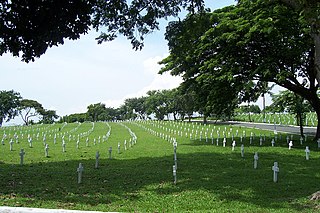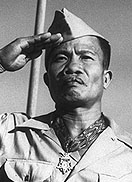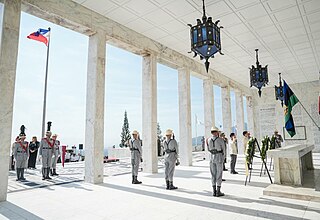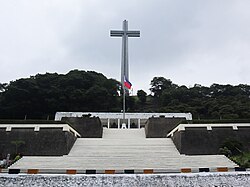
Corregidor is an island located at the entrance of Manila Bay in the southwestern part of Luzon in the Philippines, and is considered part of the Province of Cavite. Due to this location, Corregidor has historically been fortified with coastal artillery batteries to defend the entrance of Manila Bay and Manila itself from attacks by enemy warships. Located 48 kilometres (30 mi) inland, Manila is the nation's largest city and has been the most important seaport in the Philippines for centuries, from the colonial rule of Spain, Japan, and the United States, up through the establishment of the Third Philippine Republic in 1946.

Bataan, officially the Province of Bataan, is a province in the Central Luzon region of the Philippines. Its capital is the city of Balanga while Mariveles is the largest town in the province. Occupying the entire Bataan Peninsula on Luzon, Bataan is bordered by the provinces of Zambales and Pampanga to the north. The peninsula faces the South China Sea to the west and Subic Bay to the north-west, and encloses Manila Bay to the east.

Libingan ng mga Bayani is a national cemetery within Fort Bonifacio in Taguig, Philippines.

The Battle of Corregidor, fought on 5–6 May 1942, was the culmination of the Japanese campaign for the conquest of the Commonwealth of the Philippines during World War II.

The Battle of Bataan was fought by the United States and the Philippine Commonwealth against Japan during World War II. The battle represented the most intense phase of the Japanese invasion of the Philippines during World War II. In January 1942, forces of the Imperial Japanese Army and Navy invaded Luzon along with several islands in the Philippine Archipelago after the bombing of the American naval base at Pearl Harbor.

Pilar, officially the Municipality of Pilar, is a 3rd class municipality in the province of Bataan, Philippines. According to the 2020 census, it has a population of 46,239 people.

Edward Postell King, Jr. was a major general in the United States Army who gained prominence for leading the defense of the Bataan Peninsula in the Battle of Bataan against the Japanese invasion of the Philippines in World War II.

George Fleming Moore was a decorated officer of the United States Army with the rank of major general. General Moore commanded the Harbor Defenses of Manila and Subic Bays and the Philippine Coast Artillery during the Battle of Bataan.

Napoleon "Billy" Veloso Abueva was known as the "Father of Modern Philippine Sculpture" Through Proclamation No. 1539. He was proclaimed National Artist for Sculpture in 1976 when he was 46, making him the youngest recipient of the award to date.

Jose Cabalfin Calugas was a member of the Philippine Scouts during World War II. He received the Medal of Honor for actions during the Battle of Bataan.

Camp O'Donnell is a current military base and former United States military reservation in the Philippines located on Luzon island in the municipality of Capas in Tarlac. It housed the Philippine Army's newly created 71st Division and after the Americans' return, a United States Army camp. During World War II, the reservation was used as a prisoner-of-war camp for Filipino and American soldiers captured by Japan during its successful invasion of the Philippines. About 60,000 Filipino and 9,000 Americans were housed at the camp. During the few months in 1942 that Camp O'Donnell was used as a prisoner-of-war camp, about 20,000 Filipinos and 1,500 Americans died there of disease, starvation, neglect, and brutality.

The Capas National Shrine in Barangay Aranguren, Capas, Tarlac, Philippines was built by the Philippine government as a memorial to Allied soldiers who died at Camp O'Donnell at the end of the Bataan Death March during the Second World War.

The Philippine Veterans Affairs Office (PVAO) is the Philippine agency for Filipino war veterans. Under the Department of National Defense, PVAO serves to fulfill a national commitment as embodied in Section 7, Article XVI of the 1987 Philippine Constitution:

The Day of Valor, officially known as Araw ng Kagitingan, is a national observance in the Philippines which commemorates the fall of Bataan to Japanese troops during World War II. The day is officially celebrated every April 9, the start of the Bataan Death March, although the date was moved on several occasions to avoid it from coinciding with the observance of the Holy Week in the country, especially the Easter Triduum and Easter Sunday, such as in 2009 and 2023.

The Diocese of Balanga is a Latin Church diocese of the Catholic Church in the Philippines, established on March 17, 1975, by Pope Paul VI. The diocese has jurisdiction over the whole province of Bataan, with 38 parishes, 5 diocesan shrines, one minor basilica, chaplaincy, quasi-parish, national shrine and chapel, and 4 vicariates. It has 11 schools as of 2017, with 10 are operated by the diocese's Diocesan Schools of Bataan (DSOB) headed by its superintendent Fr. Roy Guila. The Cathedral-Shrine Parish of St. Joseph, Husband of Mary in Aguire Street, Poblacion, Balanga, serves as the seat of the diocese. It is part of the Ecclesiastical Province of San Fernando, Pampanga.
The Apostolic Catholic Church (ACC) is an Independent Catholic denomination established in 1992 by John Florentine L. Teruel. The ACC has its origin as a Catholic organization founded in the 1970s in Hermosa, Bataan.

The 41st Infantry Division was a division of the Philippine Army under the United States Army Forces in the Far East (USAFFE).

The Pantingan River massacre was the mass execution of Filipino and American officers and non-commissioned officers Prisoners-of-War by members of the Imperial Japanese Army during the Bataan Death March on April 12, 1942, in Bagac, Bataan. Several hundred soldiers from the Philippine Commonwealth Army's 1st, 11th, 71st, and 91st Divisions on the march to the north of Mount Samat where the Pantingan River crosses the Pilar-Bagac Road were taken to the riverside. Most of them were hog tied with telephone wire, shot, bayoneted or beheaded by the Imperial Japanese Army.

Mount Samat is a mountain in the town of Pilar, Bataan, [Philippines]]. Located near its summit is the Mount Samat National Shrine, a national shrine dedicated to the fallen Filipino and American fallen during World War II.

























